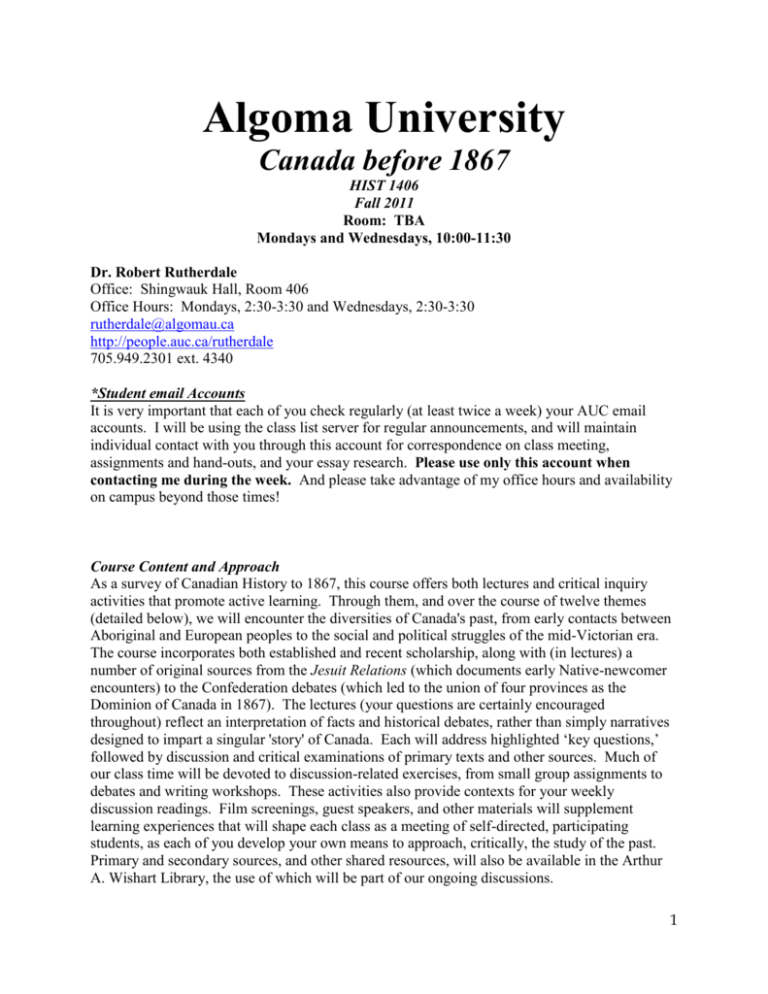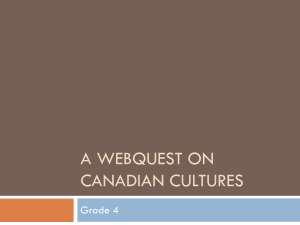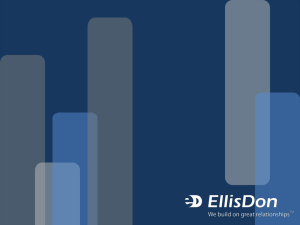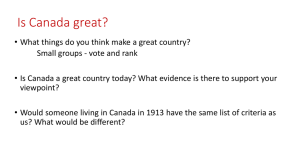
Algoma University
Canada before 1867
HIST 1406
Fall 2011
Room: TBA
Mondays and Wednesdays, 10:00-11:30
Dr. Robert Rutherdale
Office: Shingwauk Hall, Room 406
Office Hours: Mondays, 2:30-3:30 and Wednesdays, 2:30-3:30
rutherdale@algomau.ca
http://people.auc.ca/rutherdale
705.949.2301 ext. 4340
*Student email Accounts
It is very important that each of you check regularly (at least twice a week) your AUC email
accounts. I will be using the class list server for regular announcements, and will maintain
individual contact with you through this account for correspondence on class meeting,
assignments and hand-outs, and your essay research. Please use only this account when
contacting me during the week. And please take advantage of my office hours and availability
on campus beyond those times!
Course Content and Approach
As a survey of Canadian History to 1867, this course offers both lectures and critical inquiry
activities that promote active learning. Through them, and over the course of twelve themes
(detailed below), we will encounter the diversities of Canada's past, from early contacts between
Aboriginal and European peoples to the social and political struggles of the mid-Victorian era.
The course incorporates both established and recent scholarship, along with (in lectures) a
number of original sources from the Jesuit Relations (which documents early Native-newcomer
encounters) to the Confederation debates (which led to the union of four provinces as the
Dominion of Canada in 1867). The lectures (your questions are certainly encouraged
throughout) reflect an interpretation of facts and historical debates, rather than simply narratives
designed to impart a singular 'story' of Canada. Each will address highlighted ‘key questions,’
followed by discussion and critical examinations of primary texts and other sources. Much of
our class time will be devoted to discussion-related exercises, from small group assignments to
debates and writing workshops. These activities also provide contexts for your weekly
discussion readings. Film screenings, guest speakers, and other materials will supplement
learning experiences that will shape each class as a meeting of self-directed, participating
students, as each of you develop your own means to approach, critically, the study of the past.
Primary and secondary sources, and other shared resources, will also be available in the Arthur
A. Wishart Library, the use of which will be part of our ongoing discussions.
1
Required Reading
Margaret Conrad and Alvin Finkel, History of the Canadian Peoples: Beginnings to 1867, Vol.
1, 5 e (Toronto: Pearson Longman, 2009)
Readings in Canadian History: Pre-Confederation, 7 e, R. Douglas Francis and Donald B.
Smith, eds., (Toronto: Nelson Thomson, 2007)
Assignments, Choice, and Integration: Aims and Purpose: You are expected to gain a
conceptual and narrative introduction to Canadian history. An important body of core
knowledge will be introduced. However, your choice of an article to review along with your
primary source-based essay topics and in-class discussion participation will also reflect what
you, yourself, find interesting and significant within the broad domain of Canadian history
before Confederation. As your basic knowledge of the key issues and changes across regions
and periods develop, our classes will provide an open forum to test your own ideas in relation to
your ongoing learning. Finally, in covering each of the themes and questions detailed below, this
course will provide a thematic foundation for further study in Canadian fields and in history and
related subject areas generally.
Critical Review (20%) Due Week 7 (In-class hand-in, 19 Oct.): I will ask for an editorial
analysis, or 'critical review,' (1,200 words) of a refereed journal article articles presented under
any of the topic areas in your course reader, Readings in Canadian History: Pre-Confederation,
7 e, R. Douglas Francis and Donald B. Smith, eds., (Toronto: Nelson Thomson, 2007). A
handout of possible questions and approaches will be provided, and ample discussion time will
be spent on approaches and strategies.
Major Assignment (40%) Primary Document Analysis and Essay Commentary on its
Historical Significance Due Week 12, 23 Nov.
Using the useful collection of diverse primary documents available (on CD-ROM) as part of
your course textbook purchase (Margaret Conrad and Alvin Finkel, History of the Canadian
Peoples: Beginnings to 1867, Vol. 1, 5 e (Toronto: Pearson Longman, 2009), you will be
required to comment, in a 2,000 word essay, on the historical significance of your primary
source. What does your chosen text reveal? Most importantly, how would place the specific
evidence you have selected—as a text—in the historical context that generated it? To do this,
you will be required to complete secondary source research, guided by the chapter-by-chapter
‘Selected Reading’ sections that accompany your chosen primary source.
A detailed criteria guide will be provided, along with considerable class discussion for this major
assignment throughout the term.
2
Plagiarism
Plagiarism is a serious academic offence which students must be aware of in preparing essays
and other assignments. We will review Algoma University’s definition of plagiarism as outlined
in the University’s Academic Calendar, as well as the penalties that apply for ‘submitting or
presenting work in a course as one’s own when in fact it is not.’ To avoid mistaken instances of
plagiarism, you will also, as part of you class participation, report regularly on your work-inprogress and demonstrate ongoing progress in your writing projects, including proper citation
procedures.
Discussion Participation (15%)
A key part of the course, based on your contributions to weekly readings discussions, essay
writing workshops, film critiques, etc.. I will ensure that everyone is able to contribute in an
atmosphere open to new ideas, different perspectives, and creative approaches to considering the
evidence of the past.
Attendance
To engage sequentially in the accumulated experiences this course offers requires regular
attendance. Students who miss a significant number of classes, more than 20 percent 5 classes,
will not be eligible to write the final exam (unless there are extenuating circumstances I am
informed of in advance). An attendance sheet will be circulated regularly
Final Examination (25%): The exam will be set to encourage you to interpret key events,
relationships, and processes. You will be encouraged to take positions and to defend them, not
simply to demonstrate factual recall. Reviews of key themes and issues will be incorporated in
our latter class discussions, a useful exercise for connecting and integrating different topics
rather than approaching each in isolation of the others.
Lectures & Tutorials
Week 1 (First Meeting, 7 Sept.)
Course Introduction: ‘Approaches to Canada's Past: Interpretations and Perspectives’
Week 2 (12 and 14 Sept.)
Lecture: 'Contact, Trade, Warfare, and Colonization: Early Aboriginal/European Encounters
and Conflicts'
Discussion Readings and Questions: [hereafter from Readings in Canadian History: Pre
Confederation, 7 e, R. Douglas Francis and Donald B. Smith, eds., (Toronto: Nelson Thomson,
2009)]
*Bruce G. Trigger, ‘The French Presence in Huronia: The Structure of Franco-Huron Relations
in the First Half of the Seventeenth Century’
-How would you describe the location and cultural patterns of life in Huronia? What warring
factions does Trigger argue developed in response to the missionaries, and how, ultimately, did
they contribute to the destruction of the Huron as a distinct people living in regionally integrated
villages?
*Sylvia Van Kirk, ‘”Women in Between”: Indian Women in Fur Trade Society in Western
Canada’
3
-How, according to Van Kirk, did First Nations women in Canada’s western regions react
actively within developing trade relations between Natives and newcomers? Why do you think
such patterns evolved?
See also Conrad and Finkel, History of the Canadian Peoples, Vol. 1, chs. 1-5
Week 3 (19 and 21 Sept.)
Lecture: ‘New France: Society, Culture, and Economic Patterns Revisited’
Discussion Readings and Questions:
*André Lachance and Sylvie Savoie, ‘Violence, Marriage, and Family Honour: Aspects of the
Legal Regulation of Marriage in New France’
-How do Lachance and Savoie explain the social regulation of family life in New France? Why
do they see the maintenance of kinship ties as governed more by unofficial exercises of
community powers (control of family life by local citizens defending law and custom in a
hierarchical society formally bound to Church and State) than by the use of the courts?
See also Conrad and Finkel, History of the Canadian Peoples, Vol. 1, chs. 6 and 8
Week 4 (26 and 28 Sept.)
Lecture: ‘Acadian Cultural Life Before and After Dispersion: Approaches to the Resistances
and Expulsions of a Settled Population’
Discussion Readings and Questions:
*Naomi Griffiths, ‘The Golden Age: Acadian Life, 1713-1748’
-Griffiths portrays the Acadians as a people whose lives, during the their ‘golden age,’ centred
on family life and on the land, though they maintained contact with their wider social
environments in North America. Can you describe several characteristics of this way of life?
What does she mean by a golden age in light of what lay ahead in the tragic events of 1755?
See also Conrad and Finkel, History of the Canadian Peoples, Vol. 1, ch. 9
Week 5 (3 and 5 Oct.)
Lecture: ‘The Merchants, the Conquest, and Contested Social Hierarchies in Lower Canada’
Discussion Readings and Questions:
*Allan Greer, ‘The Fall of New France’
-Why, according to Greer, was the Conquest so devastating? Was the fall of the French regime
in North America inevitable, based on his discussion? Why?
*José Igartua, ‘A Change in Climate: The Conquest and the Marchands of Montreal’
-Where does Igartua stand on the ‘social decapitation’ thesis? What factors does he suggest
seriously weakened the relative position of the French-Canadian merchants vis-à-vis their
anglophone counterparts that moved into the city in the era following the Conquest?
See also Conrad and Finkel, History of the Canadian Peoples, Vol. 1, ch. 10
Thanksgiving Break
Week 6 (12 Oct.)
Lecture: ‘Canada in the American Revolution/War of Independence: The Loyalist Influxes
Northwards and Remaking of British North America’
Discussion Readings and Questions:
*Ann Gorman Condon, ‘The Family in Exile: Loyalist Social Values After the Revolution’
4
-What do the family letters that Condon uses tell us about the struggles of Loyalist refugees?
How, in your view, did their uprooting and challenges these refugees faced compare to those of
the expelled Acadians?
See also Conrad and Finkel, History of the Canadian Peoples, Vol. 1, ch. 11
Week 7 (17 and 19 Oct.)
Lecture: ‘Toward a Social History of the War of 1812’
Discussion Readings and Questions:
*Jane Errington, ‘”Woman . . . Is a Very Interesting Creature”: Some Women’s Experiences in
Early Upper Canada’
-What experiences of domesticity (family life at home) does Errington describe for married
women? What primary sources does she rely on for these descriptions (see her footnotes)? How
does this compare to the experiences of single women, and how did class at this time shape the
lives of all women in the region?
*Cecilia Morgan, ‘”Of Slender Frame and Delicate Appearance”: The Placing of Laura Secord
in the Narratives of Canadian Loyalist History’
-How does Morgan demonstrate that Laura Secord, the heroine of the war in 1812 in Upper
Canada, became a particularly significant womanly figure--one who prevailed against adversity,
but someone also whose image in the era after the American Revolution became an important
part of Upper Canada’s ‘useable past’? Consider, too, the significance of gender in latter
constructions of Secord’s image, long after her courageous act one night during war against the
Americans on the Niagara peninsula.
See also Conrad and Finkel, History of the Canadian Peoples, Vol. 1, ch. 12
Week 8 (24 and 26 Oct.)
Lecture: 'Prelude, Performances, and Aftermaths Reconsidered: Rebellions in Upper and
Lower Canada, 1837-1838'
Discussion Readings and Questions:
*Allen Greer, ‘From Folklore to Revolution: Charivaris and the Lower Canadian Rebellion of
1837’
-What role to Charivaris play in the Rebellion of 1837 in Lower Canada
*Colin Read, ‘The Rebellion of 1837 in Upper Canada’
-What key developments in the politics, economy, and society up to 1837 does Reid attribute to
the causes of Upper Canada’s Rebellion?
See also Conrad and Finkel, History of the Canadian Peoples, Vol. 1, ch. 17
Week 9 (31 Oct. and 2 Nov.)
Lecture: ‘Red River from the 1830s to Confederation: Métis Culture and Economies in the
Prairie West’
Discussion Readings and Questions:
*Frits Pannekoek, ‘A Flock Divided: Factions and Feuds at Red River’
-How did the influx of new populations alter Red River social life in the generation leading up to
the Dominion era? What four major groups does Pannekoek identify, and why was such a social
mix so significant for the future of Rupert’s Land?
See also Conrad and Finkel, History of the Canadian Peoples, Vol. 1, chs. 13 and 18
5
Week 10 (7 and 9 Nov.)
Lecture: ‘Rocky Roads to Responsible Government: Political Cultures in Developing Colonial
Settings’
Discussion Readings and Questions:
*Scott W. See, ‘The Orange Order in Mid-Nineteenth Century Saint John’
-How does See connect the origins and consequence of sectarian (Protestant versus Catholic, in
this case) violence through the social history of New Brunswick’s port communities of Saint
John to changing political culture (the power exercised and support garnered by politicians) in
the communities assessed? What does he mean by a strong ‘nativist’ sentiment among the
settled population (mostly Protestant) in the mid-19th century?
See also Conrad and Finkel, History of the Canadian Peoples, Vol. 1, ch. 17
Week 11 (14 and 16 Nov.)
Lecture: 'Social Reform Impetus and Expanding Industrialization and Urbanization at Midcentury'
Discussion Readings and Questions:
*Carolyn Podruchny, ‘Unfair Masters and Rascally Servants? Labour Relations among
Bourgeois, Clerks, and Voyageurs in the Montréal Fur Trade’
-How does Podruchny characterize relationships between the Voyageurs and the companies they
worked for? How did both formal and informal rules of labour engagement combine for these
younger men and their ‘masters’?
*Shirley Yee, ‘Gender Ideology and Black Women as Community-Builders in Ontario, 18501870’
-What contributions did Black Canadian women make to their communities from the mid-19th
century to the Confederation era? What challenges did they overcome? What opportunities did
they pursue (please list several examples)?
See also Conrad and Finkel, History of the Canadian Peoples, Vol. 1, chs. 16 and 20-22
Week 12 (21 and 23 Nov.)
Lecture: ‘Contingent Events, Enduring Challenges, and the Outcome of the British North
American Act of 1867’ Part I
*A.I. Silver, ‘Confederation and Quebec’
-In contrasting the arguments of Georges-Étienne Cartier (and les bleus) with Antoine Dorion
(and les rouges) how might we argue that Confederation was as hotly-contested a debate in
Quebec as it was in the Maritimes and in Upper Canada?
See also Conrad and Finkel, History of the Canadian Peoples, Vol. 1, ch. 23
Week 13 (28 Nov. and 30 Nov.)
Lecture: ‘Contingent Events, Enduring Challenges, and the Outcome of the British North
American Act of 1867’ Part II
Week 14 (5 Dec.)
*Course review and in-class preparations for final examination
6







